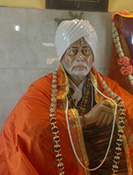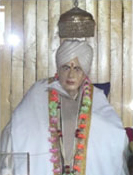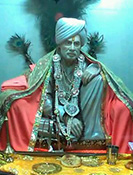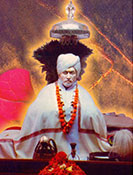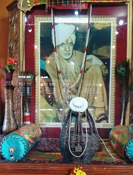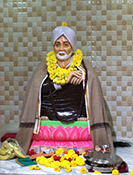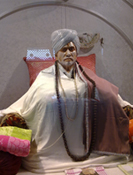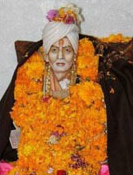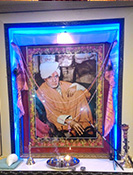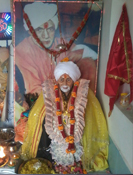Bab Bhagavaan Gopinath Ji Speaks through Silence
He who does not deviate from AUM, which is the source of all things, is a man of God. He who does not deviate from the Sadhana/ quest for Ultimate Brahman-Reality or perfection is a Bhakta. For realizing the Ekakshara AUM,two schools of thoughts evolved in the Vedic Sanatana Dharma. One school is intuitive,in seeing the Truth in Shruti--the Vedic Mantras/Samhitas. They lived as Ashramites,married ,had children abd continued to develop the Vedic literatureaccording their intuitive faculty,hence evolved the Gotra system in Bharata.They preferred to do Nitya Niyam Sandhya,Tarpan, Agni Homa,Atithi Puja and above all in teaching the Vedic Mantras.
Hence different Chhandas,Devatas,Mantras evolved with the pessage of time,and the four Vedas weredocumented by the Veda Vyasa ,purely to see the expertise in each of the Vedas. This system became wider and wider,with the result the huge literature consisting of the Upanishads,Arnyaka Shastras,attitude towards life on earth,were given great importance. The aim of the Rishi was to see the Santana Dharma ontegrated within the Traitavaada--i.e. Parmatma, Jivatma and Prakriti,upholding the Varna and Ashrama system. It gave rise to the Vedic Tapovans known as Gurukulasystem of education.These Gurukuls created the Avatars like Shri Rama and Shri Krishna..The aim of this system was to justify the existence og God on the basis of Shruti. These Rishis were not the Sanyasis.These were the Grihasthis,who lived the highest spiritual life through Havans, meditation, and through pilgrimage. All the Vedic Rishis knew the highst realms of Brahma,Vishnu andShiva,including the Para-Prakriti in Bhu devi,Lakshmi Durga as the forms of Divine in the Motherhood aspect of God/Divinity
Therfore the Brahman Granthaswerecomposed by the Rishis in the Arnyas--in the forests as Vaana Prasthis.
They were more concerned about the Jnana
The modes of thye Atharva Vedas was for healing purposes,and more of the material benefits,Thwerefore,the Prana Pratishttha Mantras were formulated giving shape to the shapeless Divine throughBija Mantras.Thus came the concept opf Nataraja giving 14 beats with Damaru,and made Panini Rishi tio formulate the Ashta-Adhyayi --the bed rock to understand thevedic Sanskrit,along with the help of Niruklta.
The second school of the Vedic lore are called the Munis,who are always in conteplation. They are more introverts. They know theVedic Mantras with their innate meaning,but wouldbe always in tune with the vibrational atmosphere of the Divine word AUM.or the Bijaksharas. It lead to Japam, and Mantra Mala. They are inclined toward the HatthaYoga, whilw the Rishis are doing Yoga ,which is Shaj Yoga.. Sometimes the Munis are revered as the rishis as well,even though they do not speak the Deva vani--Vedic Sanskrit. They too have the compassionate heart like Rishis,but Munis are for Self-realization/Atmano Mokshartham and the Rishi is for Atmano Mokshartham Jagat Hitaaya Cha.
It is unique example of Bab Bhagwan ji,as told by Pran Nath Kaul ji,on11th of August,2010 that Bab Ji would do Havan,from Suryodaya toSuryast--dawn to dusk.He would perform the havan regularly,using the Mondya-- pieces of unbroken logs cut into particular size to fit in the SIGRI--metalic Havan Kunda. He would not use any Shruka and Shruva as is the Kashmiri Pandit tradition of doing the Havans Rather he would offer it with hand, and seeing if the flame lit and was properly.high up . His Samagri was of dried fruits--almomd,peach,lotus roots and dried coconuts''.He would invariably use Desi Shakar,which is raw sugar without crystals
When I asked Pran Nath ji. What Mantra he was reciting during the Ahuti. P N Kaul ji said: He was doing the homa within.Further he would do this Homa for 24 hours or 36 hours. When I posed him the question why,he said: Simply to ward off the death of any of his devotees, or when there would be some natural calamity and or during war times.
In my humble understanding Bab ji was the blend of Rishi and Muni. How? He would perform the Havans,but no rituals,even he did not follow any invocation ,or Anushtthans.He would put on Tyok, blended with Chandan,Kesar ,and would apply the Bhasam in the center of the tilakam. This confirms that he believed in the Trika system of Self-realization,where the Triadic role is more convenient,to real ize thruth through Jnana,but keeping the tradition alive.likeTilakam,Datar ,Pheran and PotScha.
He would regularly recite the Gayatri Mantra while putting on therYajneopavit around his nech in the Savyana form.
His way was like the ParamaHansa,as he would gaze at the flamemore and more. In his "Ashram like Room" , there used to be the pictures of Shri Ramakrishna Param Hansa and Mata Sharada Devi. He would have the Gauri Tritiya picture also in his Place of Sadhana. His message is more mystic and understandable through imagery ,symbols and face gestures.
There was the picture of the great Saint Satpurush revered as Pandit Balak Joo Kaw of Rainawari, as revealed by P N Koul ji. This confirms Bab ji was graced by the great souls of realization like Shri Ramakrishna Param Hamsa Mata Sharada devi and Pandit Balak Joo Kaw.
PN Koul Ji told me that on his Nirvana day, he applied Sindoor Tilkam, instead of the Sandal, saffron and Bhasam , The Tyoks as called in Kashmiri was dazling,shining giving a superb radiance on his face. P N Koul has seen him early morning on 28.05.1968, before attending to the Govt. High School Rainawari, where he was working as a trained graduate teacher.
This was his last Darshana, while seeing him in the physical body,so lutrous,so serene,so beautiful. The grace was there in and around.
How to receive Bhagavaan Ji’s Grace?
He, who does not deviate from the Essence of Bhagavaan Ji’s gospel, is always a beneficiary of the Grace.
We need to understand his silence and body language, and for that matter the words like Sezar--Pazar Shvazar, should be taken as in the Prasthan Trayi.
Sanatana Dharma speaks of Guru-Shishya Bhava, as is evedent from the life of Shri Rama and Shri Krishna. Shri Rama learnt Brhma Jnana from his Kula Guru Vashishta, and excellence in the Military sciences from Guru Vishwamitra. Shri Krishna also learnt the Vedas from his Guru Sandipn. That is why Bhagavaan Ji used to recite the Guru Gita. Bhagavaan Ji was himself a Siddha Purusha. Even then, he followed the example of great Incarnations, and absorbed himself in writing Sharada AUM, and reciting Guru Gita.
Inspite of his inner feelings, that he himself has to merge with the Absolute, even then, he like the Buddha wanted that all others can rise to the spiritual heights, if he merges with Aum, and lives the life with SEZAR-PAZR-SHOZAR.
This is , in my humble way to learn the basic discipline of GURU-SHISHYA BHAAVA. He who neither values his Guru, nor remembers the lesson, given by the Guru can never become spiritually evolved.
Approach to Realization
To live in the cave of realization, a spiritual journey to consciousness is needed. The cave is the Dhyana of the physical form of Bab Bhagavaan. The spiritual journey is the recitation of Guru Gita. A mystic experience should be taken as the Divine Grace of Shriman Bab Bhagavaan. It is the reflection of the inner-self, known as the Antaratman. It is a higher bliss not to be spoken, but to be shared through the SEVA-BHAVA of the humanity at large. This is both Nara-Seva/ service to humanity and Narayana-Seva/ dedication to the aura of Bab Bhagavaan. It is rather a direct experience. The Bhakta is to see the ‘Mirror of Self’ in silence. Silence is speaking to the soul. It is expressing and communicating with the Divine. This is the First step to learn from the Leela of Bhagavaan Ji.. It is His wonderful Diksha , as well as to be the part and parcel of the Will of Shakti Sharika. With this Bija –Mantra of Silence, he transformed the lives of his devotees. To visualize the SHUNYA, is not only a Mantra, but to see the Reality of Bhagavaan Bab in His subtle form. This approach is unconditional; it is not for asking boons and favours, but being the part of His consciousness. This is Tapasya / the austerity to live for higher consciousness.
His Maha Mantra for the humanity is SEZAR-PAZAR-SHOZAR. This is verily, his observation. He never authored books or gave the big Pravachans/ sermons, but talked with his true nature of realization. SEZAR is the base of Sadhana. It is the quintessential of the Narada’s Bhakti Sutra. Sezar is straight forwardness, but it has a deep meaning, beyond that. It is to live in peace and allow others to live in peace. BAB Bhagavaan understood this aphorism in principle and its application All visible directions in the space and all conditions of the time, from subtle to the gross are to be dealt within the realm of SEZAR., Sezar is the Eternal Truth , not a book, written with academic resources, which are often subject to change, but Sezar is Sanatana Dharma.
The world is in chaos, there seems to be conflict of interests, and the humanity is at stake. The ways of wise and sages- in- incarnation need to be understood and their role in life to be understood, with respect to the situation. There will be peace alone then. Bab lived for others, to share love , to express the beauty of the Divine Mother in the realms of Shri Ragnya and Sharika, for the devotees. Spiritual vibrations are received there, which are revered as the Siddha Pitthas of Kashmir. He never strived for posthumous fame, he never wanted to waste money for pomp and show, he did not create specific laws for the Ashramite life, but asked a child, an adult, a young man/woman and an elderly person to live the life, embedded or rooted in SEZAR. He never dressed himself in the ochre clothes, but preferred to be in the typical Kashmiri Pandit robe, which is Pheran and Dastar. He would apply Tyok, which is a must for a follower of Sanatana Dharma. It is to recognize Shiva. This is the Sezar of his life. Sezar is the sweetness of Vimarsha/ Shakti Tattva to be tasted and Prakash/ light of Shiva to be seen for living a harmonious life within the family norms. It forms the strong bed-rock for spiritual evolvement. It embraces the purity of Dharma, in the rituals as well. Sezar is the relationship, between Arjuna and Bhagwan Krishna, where there is no ego in both the Guru and disciple. It is universal consciousness. We need to take this Sutra with dedication, whether we are students, house holders, or in other fields of life. No doubt, Sezar is provoked by the oppressive forces.
PAZAR helps the hostile forces to think twice. Pazar is Ekam Sad/Truth is One. Truth is All existence. Truth is rhe Brahman of the Guru Gita.
Dr Chaman Lal Raina






